
Barre Circle is a small neighborhood in Baltimore, Maryland, United States. It is often considered to be a part of Pigtown. Most of the neighborhood's historic homes range from 1840 to 1890, with many populated by graduate students at the nearby University of Maryland's Baltimore campus. It is walking distance to the Inner Harbor and the MARC Train's Camden Station.

The Alex. Brown & Sons building is a historical structure located at 135 East Baltimore Street in Baltimore, Maryland. During the 20th century it served as the corporate headquarters for the banking firm Alex. Brown & Sons, the oldest in the United States when it was purchased by Bankers Trust in 1997. The two story building, completed in 1901 and designed by the partnership of J. Harleston Parker and Douglas H. Thomas. Jr., survived the 1904 Baltimore fire. The building was modified on the Calvert Street side and in the interior by the firm Beecher, Friz, and Gregg in 1905.
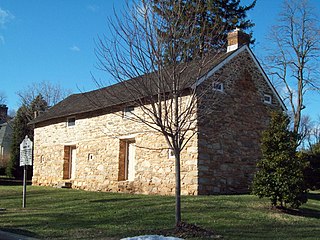
Fort Garrison, also known as Oulton's Garrison, Risteau's Garrison, and Olton's Garrison, is a historic fortification building located at Stevenson, Baltimore County, Maryland on Garrison Farms Court. It is a rectangular fieldstone building built about 1695. The fort was built to serve as a stronghold against attacks by Native Americans and was used during the French and Indian War. It is approximately 48 feet long and 18 feet wide with one large stone fireplace. Modifications in the early-19th century raised the height of the fort building adding a second story loft and a wood shingle roof. It was constructed following a 1693 order from Governor Francis Nicholson and his Council. The property was acquired in 1965 by the Baltimore County Department of Recreation and Parks.

Holy Cross Roman Catholic Church is a historic Roman Catholic church complex located within the Archdiocese of Baltimore in the Federal Hill neighborhood of Baltimore, Maryland, United States.

Building at 423 West Baltimore Street is a historic retail and wholesale building located at Baltimore, Maryland, United States. It is a five-story loft structure of the Queen Anne style. It achieved its present configuration in 1893, as the result of extensive alteration of an existing three-story brick warehouse. The storefront retains its important cast-iron elements, and the upper floors are essentially unchanged.

Johnston Building was a historic wholesale building located at Baltimore, Maryland, United States designed by Jackson C. Gott. It is a five-story loft building constructed in 1880. The cast iron façade reflected the influence of the Queen Anne style. It housed wholesale companies dealing in tobacco, hats, shoes, clothing, and home and office furnishings, including Samuel Hecht, Jr. & Sons. It was demolished in 2002.
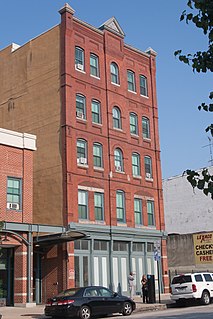
The Sanitary Laundry Company Building is a historic building located at Baltimore, Maryland, United States. It is a five-bay wide, five-story brick loft building constructed in 1883. The façade features a cast-iron storefront at street level and the elaborate decorative brickwork and terra cotta ornamentation on the upper floors reflect the influence of the Queen Anne style. It was built originally as a slaughterhouse and meat packing plant until 1897, when it was converted to a commercial laundry.

Swiss Steam Laundry Building, also known as the Swiss Building, is a historic loft building located at Baltimore, Maryland, United States. It is a Romanesque Revival-style six-story structure. The façade is dominated by two five-story arched bays each consisting of tripartite fenestration at the corners and a cast iron storefront with an ornamental scroll and egg-and-dart molding at the cornice. The interior of the building features iron columns and wood flooring. The first two floors are 20 feet high. The third and fourth floors are 16 feet high, while the uppermost floors are 10 feet high. It was built in 1895 as a manufacturers’ laundry.

Erlanger Buildings is a historic loft building located at Baltimore, Maryland, United States. It consists of a four-structure, turn-of-the-20th-century loft complex. The buildings range in size from two to six stories high and feature iron storefronts and stone detailing. They were built between 1892 and 1910. The buildings served as the home of the Erlanger Manufacturing Company, which produced BVD brand underwear. Charles Erlanger, co-founder of the company, is credited with making major advances in the design of underwear which revolutionized the industry.

Gandy Belting Company Building is a historic loft building located at Baltimore, Maryland, United States. It is a brick masonry bearing-wall structure built in five sections. The sections built in 1888, 1890, and 1908 are four stories in height. The remaining two sections, built in 1908-1911 and 1911 respectively, are five stories in height. The Gandy Belting Company, (1888-1931) manufactureer of machinery belting.

Heiser, Rosenfeld, and Strauss Buildings, also known as Inner Harbor Lofts I, is a historic loft building located at Baltimore, Maryland, United States. It is a complex of three structures. The Heiser Building is a Romanesque Revival style, six-story brick, stone, and iron structure, eight bays wide and 14 bays deep, built as a show factory in 1886. The Rosenfeld Building is a six-story, five-bay loft building, with Beaux Arts styling and built for E. Rosenfeld and Company in 1905. The Strauss Building is a six-story high, six-bay wide, and 11-bay deep loft structure built in 1887 for the Kinny Tobacco Company, cigarette manufacturers, and later occupied by the Strauss Brothers, clothing manufacturers and became part of the Rosenfeld complex around 1910.
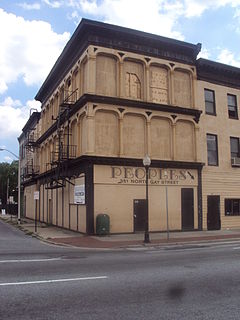
Old Town Savings Bank, also known as Cala Brothers, is a historic loft building located at Baltimore, Maryland, United States. It is a three-story loft structure designed by architect Frank E. Davis (1839-1921) and constructed in 1871. Both the street façades are cast iron, four bays wide on Gay Street and eight bays wide on Exeter Street. It is a Full Cast Iron Front building. It operated as a bank until about 1940, then housed a wholesale distributor of tobacco and confectionery.

Maryland White Lead Works is a historic lead paint factory complex located at Baltimore, Maryland, United States. It is a "U"-shaped industrial complex constructed about 1867. It consists of nine interconnected brick and wood-frame buildings, which vary in height from one to four stories, surrounding a yard. The complex includes the powerhouse, two production sheds, a manufactory loft with an office wing, and a service building. The Maryland White Lead Company occupied the site from 1867 to 1896, Baltimore's first and most substantial manufacturer of lead paints.

Rombro Building is a historic loft building located at Baltimore, Maryland, United States. It is a six-story loft building constructed in 1881, and designed as a double warehouse. The first floor storefronts feature brick, stone, terra cotta, and cast iron framing and reflects the Queen Anne style in its facade organization and detailing.
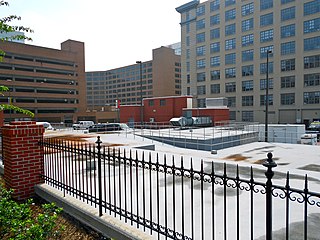
Turner-White Casket Co. Building was a historic loft building located at Baltimore, Maryland, United States. It was a six-story loft building constructed in 1893 in the Romanesque style. Its façade organization and detailing featured brick, stone, and cast iron elements. It was two bays wide and six stories high with a full basement.
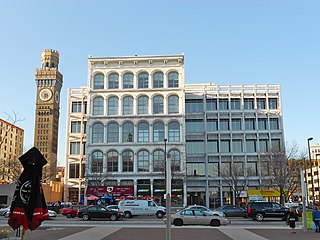
Wilkens–Robins Building is a historic loft building located at Baltimore, Maryland, United States. It was built in 1871 and is a five-story, six-bay brick structure with a cast iron front. It is approximately 80 feet (24 m) tall, 50 feet (15 m) wide, and 110 feet (34 m) deep with a gently sloping roof. The facade features an expanse of oversized windows and are the highlights of one of the few surviving cast-iron facades in Baltimore.

The Loft Historic District North is a national historic district in Baltimore, Maryland, United States. It includes 12 large 19th–early 20th century vertical brick manufacturing buildings centering on Paca, Redwood, and Eutaw Streets near the University of Maryland Campus in downtown Baltimore. Most of the buildings are still used for manufacturing purposes, although a few, including the Heiser, Rosenfeld, and Strauss buildings, have been converted into loft apartments or offices. They are representative of Romanesque, Victorian, and early modern industrial architectural design. It was in this area that Baltimore's garment industry grew to national importance.

The Loft Historic District South is a national historic district in Baltimore, Maryland, United States. It includes seven large brick manufacturing buildings on both sides of the 500 block of West Pratt Street near the University of Maryland campus in downtown Baltimore. Of the seven buildings, four have been converted into a loft apartment building complex known as the Greenehouse. The district includes the Sonneborn Building.

Stone Hill Historic District is a national historic district in Baltimore, Maryland, United States. It is one of the original mill villages along the Jones Falls, having been developed circa 1845–1847 to house textile mill workers. Comprising seven blocks, the district includes 21 granite duplexes, a granite Superintendent's House, and a granite service building – all owned by Mount Vernon Mills from 1845 to 1925.
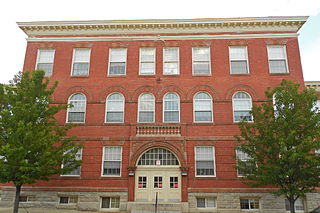
Franklin Square Historic District is a national historic district in Baltimore, Maryland, United States. It is a 19th-century rowhouse neighborhood developed along a strict grid street pattern. A one square block, two and a half acre public park, Franklin Square, is a focal point for the area and the most elaborate rowhousing surrounds the square. The district contains approximately 1,300 buildings of which approximately 1,250 contribute to the significance of the historic district.

























